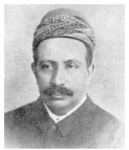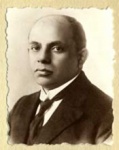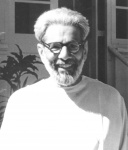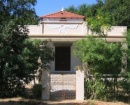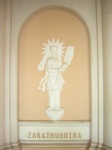User:SysopJ/My sandbox: Difference between revisions
| Line 2: | Line 2: | ||
=== Early history === | === Early history === | ||
Zoroastrians of the Parsi community were heavily engaged with the [[Theosophical Society]] [[Founders]], [[Henry Steel Olcott]] and [[Helena Petrovna Blavatsky]], even before the two stepped ashore at Bombay for he first time in 1879. Colonel Olcott wrote of his early contacts in his autobiography,[[Old Diary Leaves (book)|''Old Diary Leaves'']]. | |||
<blockquote> | |||
It has been remarked already that the Bombay Parsis were friendly from the beginning, calling upon us with their families in numbers, asking us to their homes, dining with us, and pressing me to preside and distribute prizes at an anniversary of a Parsi girls’ school. While | |||
still in America, I had made friendly overtures to Mr. K. M. Shroff, who had just completed a lecturing tour in my country and returned home. He accepted membership and on all occasions after our arrival at Bombay, rendered us loyal help.<ref>H. S. Olcott, "Old Diary Leaves Oriental Series - Chapter III" The Theosophist 16 no. 3 (December 1894): 138.</ref> | |||
</blockquote> | |||
<blockquote> | |||
Influential Parsi gentlemen ... called on us, among them Mr. K. It. Cama, the Orientalist, and his famous father-in-latv, the late Mr. Manockjee Cursetjee, the reforming pioneer, whose charming daughters were with him, received at several European Courts and universally admired.<ref>H. S. Olcott, "Old Diary Leaves Oriental Series - Chapter III" The Theosophist 16 no. 3 (December 1894): 138.</ref> | |||
</blockquote> | |||
Hindus and Parsis, including [[Sorabji J. Padshah]], joined a delegation in a good-will visit to the Buddhists of Ceylon in May, 1880. Interfaith cooperation ............. | |||
=== Prominent Zoroastrian Theosophists === | === Prominent Zoroastrian Theosophists === | ||
Revision as of 15:17, 8 September 2023
Zoroastrians and the Theosophical Society
Early history
Zoroastrians of the Parsi community were heavily engaged with the Theosophical Society Founders, Henry Steel Olcott and Helena Petrovna Blavatsky, even before the two stepped ashore at Bombay for he first time in 1879. Colonel Olcott wrote of his early contacts in his autobiography,Old Diary Leaves.
It has been remarked already that the Bombay Parsis were friendly from the beginning, calling upon us with their families in numbers, asking us to their homes, dining with us, and pressing me to preside and distribute prizes at an anniversary of a Parsi girls’ school. While still in America, I had made friendly overtures to Mr. K. M. Shroff, who had just completed a lecturing tour in my country and returned home. He accepted membership and on all occasions after our arrival at Bombay, rendered us loyal help.[1]
Influential Parsi gentlemen ... called on us, among them Mr. K. It. Cama, the Orientalist, and his famous father-in-latv, the late Mr. Manockjee Cursetjee, the reforming pioneer, whose charming daughters were with him, received at several European Courts and universally admired.[2]
Hindus and Parsis, including Sorabji J. Padshah, joined a delegation in a good-will visit to the Buddhists of Ceylon in May, 1880. Interfaith cooperation .............
Prominent Zoroastrian Theosophists
These practitioners of Zoroastrianism were Theosophists or were significant to the Theosophical movement. Two culturally distinct groups of Zoroastrians exist in India: Parsis or Parsees, who descended from Persians who emigrated to India in the 8th and 10th centuries CE; and Iranis, who made a similar migration many centuries later. Theosophists were generally Parsis.
N. D. Khandalavala (Khān Bahādur Navroji Dorabji Khandalavala) was a provincial judge who greatly assisted the Founders after becoming a member in 1879. He corresponded with Madame Blavatsky, who disclosed to him important information about the Mahatmas and other matters.
K. M. Shroff was a highly educated Parsi member in Bombay. In 1874 he lectured in the United States, and Shroff joined the Theosophical Society by corresponding with the Founders before they left New York, making him one of the earliest Indian members. He was vice president of the Bombay Branch from 1882 to 1885, a member of the TS General Council, and a major speaker at the 1882 convention. Col. Olcott referred to him as “the all-accomplishing Mr. K. M. Shroff.”[3] Certainly, he was persuasive and energetic; and he helped to establish the Homeopathic Charitable Dispensary and Bombay Veterinary College and Hospital, working with Tukaram Tatya. Shroff testified in support of HPB in the Vega incident. In 1883 he become editor of the Jam-e-Jamshed daily newspaper published in Gujarati and English.
Sorabji J. Padshah (1856-1927) was another Parsi who joined the Society in 1880. He traveled with the Founders on their first trip to Ceylon, and served as Assistant Recording Secretary and on the General Council. In 1881 he received an encouraging letter from Master K.H., but after a few years he lost interest in Theosophy. His younger brother Burjorji J. Padshah (1864-1941) was a mathematics professor trained at Cambridge. He exerted great influence on the development of India’s largest conglomerate, the Tata Group, and on establishment of the Indian Institute of Science. He practiced Theosophical principles his whole life, abstaining from meat, leather, alcohol, and tobacco and advocating for animal welfare.
B. P. Wadia (1881-1958) was an important figure in the Theosophical Movement in the twentieth century. After joining the Theosophical Society in Bombay in 1904, he worked in the publishing house of the Society. He was interned by the British in 1917 with Annie Besant and George S. Arundale. In 1922, he resigned very publicly from the Adyar-based Society to embrace the United Lodge of Theosophists and its strict focus on the original writings of H. P. Blavatsky. He was a prolific and influential writer and editor.
Dinshah P. Ghadiali (1873-1966) was born in India but became a naturalized American citizen. His interests in medicine and electrical engineering led to patenting the Spectro-Chrome device for light therapy. He was a member of the Theosophical Society from 1891 to 1966, and published at least 16 books.
Adyar headquarters
The residence of international Theosophical Society president Radha Burnier in the headquarters estate was called Parsi House. That campus also has a Zoroastrian Temple. Zarathustra, the founder of Zoroastrianism, is carved in relief on a wall of the Great Hall of the Headquarters building.
